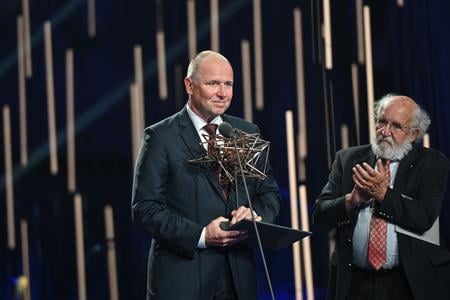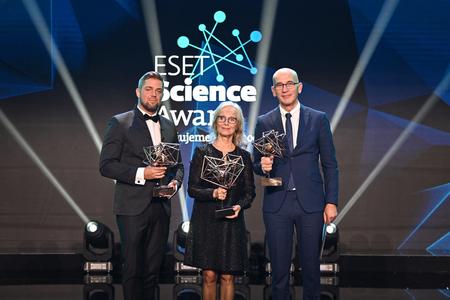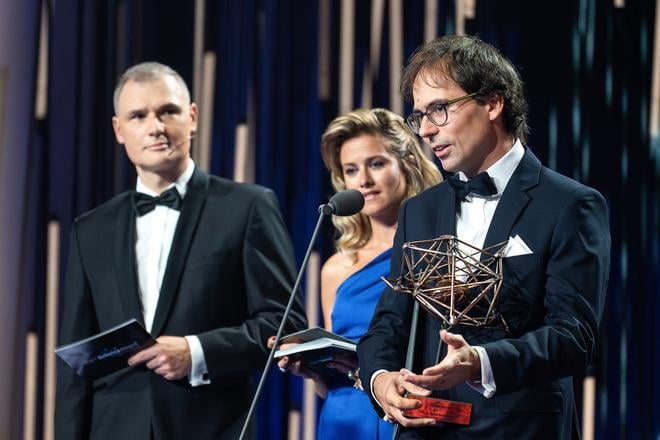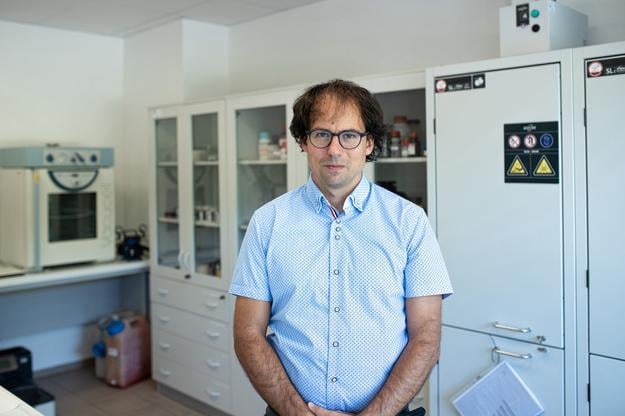You could be forgiven for not having come across the scientific field that Matej Baláž works in. Only a relatively small number of people anywhere in the world are dedicated to mechanochemistry. Nevertheless, it can do some very interesting and useful things, such as repurposing eggshells for use in waste-water treatment, or transforming nutshells into activated charcoal.
This article is supported by the ESET Foundation, whose annual ESET Science Award recognises exceptional scientists.
Matej Baláž works at the Institute of Geotechnics of the Slovak Academy of Sciences in Košice. His accomplishments in the field of mechanochemistry resulted in him winning this year’s ESET Science Award in the category of ‘Outstanding Scientist in Slovakia Under 35 Years of Age’.
"In classical chemistry, you often have to heat the reaction vessels in order for reactions to take place within them. In our case, the reactions are achieved through grinding – by transferring mechanical energy, via grinding balls, to powder. Moreover, the former is often a multi-step process," Baláž says, laying out the basic idea behind the field in an interview with The Slovak Spectator.
"In mechanochemistry, we use solid-phase substances. When you imagine two liquids, they are easily mixed through diffusion. With solid substances, it is more difficult. That is why grinding helps with their mixing, so that the reacting particles come into contact with each other more frequently," he continues.

To stay up to date with what scientists in Slovakia or Slovak scientists around the world are doing, subscribe to the Slovak Science newsletter, which will be sent to readers free of charge four times a year.
Even he did not know about it
Although mechanochemistry is not a well-known scientific field, it could be said that some of its beginnings can be traced back to the Stone Age, when ancient people started fires by banging stones together. The first documented manmade mechanochemical reaction took place in 315 BC, when the Greek philosopher and botanist Theophrastus mechanically crushed cinnabar in a copper mortar and pestle in the presence of vinegar.
"He began to press on it with mechanical energy and droplets of mercury appeared in the mortar. Cinnabar contains mercury and sulphur and the latter reacted with copper present in the mortar and pestle, forming copper sulphide, also known as covellite. However, this was rather unsystematic discovery," Baláž explains, adding that dedicated research only started in the Soviet Union in the 1960s. A little later, the Department of Mechanochemistry was established at his current workplace.
However, everything revolved primarily around the processing of raw materials from mining. It wasn't until around 2000 that the rest of the world became more interested in mechanochemistry.
"If I didn't have a father who works in the field, I wouldn’t know about it – and I studied chemistry at university. It’s basically a small community of people who do it, so it’s not that well known." His father played a key role in his decision to devote himself to the field. He didn’t pressure him; instead, he presented him with a positive example. It also helped that Baláž had a good chemistry teacher in high school. And although Baláž himself is an organic chemist and his father an inorganic chemist, they work together in mechanochemistry.
With the mining industry declining in Slovakia, partly because of the need to protect the environment, mechanochemistry has found a paradoxical application – Matej Baláž uses it to find ways to clean the environment. In his dissertation, he wrote about the use of a common kitchen waste product – eggshells – for water purification.
The idea to start this research came from his father, who showed him literature about grinding seashells and using them to purify waste water by removing potentially dangerous elements like heavy metals. Seashells have a similar composition to eggshells: both are rich in calcium, in the form of calcium carbonate. The process works as follows.
"In principle, there is an exchange – calcium leaves the shell so that another ion can take its place, for example, ions of heavy metals such as silver and cadmium. The shell basically captures them," explains Baláž, adding that this characteristic of the shell is further increased by grinding. There are two reasons for this.
"One is that we have increased the specific surface area and obtained finer powder, so that it interacts better with the waste-containing solution. The second is that in the shell, calcium carbonate exists in the form of calcite, a mineral with a certain crystal structure. There is also the mineral aragonite, which is a different crystalline form of calcium carbonate. By grinding, we converted the calcite into aragonite, which turns out to be better at capturing the given ions."
Various advantages
It is possible to grind all kinds of things. In his work, Baláž uses commercially available powders or waste materials, including biomass.
"In that case it's a bit different than with eggshells, because biomass such as plants don't contain much calcium, but carbon instead. When you burn the powder at higher temperatures in the presence of an inert gas, you get activated carbon that absorbs everything," he explains.
It is not always just about grinding the material, but usually just "activating" it, which means that mechanical energy will slightly alter certain properties. For example, when the surface of a material is increased in some way, this can improve its reactive properties.
In addition to waste processing, mechanochemistry is also used in cosmetics or in obtaining substances from natural materials. It can also be used to obtain products that cannot be extracted by dissolving them – the technique used in much of classical chemistry. Another advantage is that it causes chemical reactions without the need for various solvents and the addition of external temperature, making it a more environmentally friendly approach.
"Our goal is to verify these processes in a laboratory setting and then show them to the world by publishing papers in journals. Of course, it would be great if someone takes it, via a start-up, to another level," says the scientist.

Cooperation is key to success
Baláž admits that many things would not be possible without cooperation. This is why he came to forge contacts in 90 institutions in 30 different countries.
"If I need something for which I don't have the instruments, I know where to turn. Without such cooperation, good science cannot be done," he says. He cooperates, for example, with doctoral students from Kazakhstan. The country has a program that requires young scientists to have a foreign supervisor and to travel to that person’s workplace for three months.
"I also collaborate a lot with a colleague from Slovenia who works in transmission electron microscopy. When we grind something, it's very good to see how the particles actually look on the nanometre [one billionth of a metre – Ed.] scale. We have such a microscope in Košice, but the colleague in Slovenia has experience with analysing mechanochemically prepared materials, so it is easy for her to provide logical interpretation," he explains.
Baláž considers his research into silver particles with antibacterial properties, which he obtains by grinding powdered plants with silver nitrate powder, to be one of his successes too. The principle is in the solid-state reduction of silver ions into zero-valent silver by utilizing reducing species present in the plant.
"Nobody had researched this area. The classical approach involves the plant being turned into a kind of tea (extract), which is then mixed with a silver nitrate solution. However, our procedure is more straight forward," he explains.

An intriguing reaction
His current research involves the aforementioned covellite and its preparation from copper and sulphur, which Baláž describes as an explosive synthesis.
"You put both powders into the grinding chamber, add a little bit of energy via the grinding balls, and suddenly you have a product," he says, adding that this product is widely used in energy conversion applications (e.g. in thermoelectric, solar cells or for the production of hydrogen).
The advantage is that it can be prepared in this way in about 10 seconds. He is now trying to find out how this occurs, because several different types of copper were tried but in only two cases was the reaction successful. So far, he and his colleagues have discovered that the shape of the particles – needle-shaped particles are particularly reactive – and their size are important.
"The reaction of copper and sulphur is super-fast. It is assumed it can work in other systems too, not just with copper and sulphur. Most importantly, we don't know why it works like that. Suddenly, there is a small explosion, heat and pressure are released, and when we open the chamber we have a product," he explains.
Baláž wants to apply for an ERC grant to contribute to his research. In support of this effort he has travelled to Germany as part of an ERC Visiting Fellowship, in order to learn from his German colleagues’ know-how, since Slovaks have had little success in obtaining ERC grants.
"I don't give it much of a chance, but at least I gained some experience and I will see how the whole procedure of this prestigious grant submission works," he adds.
This article is supported by the ESET Foundation, whose annual ESET Science Award recognises exceptional scientists.


 Matej Baláž (right). (source: ESET Science Award/Linda Kisková Bohušová)
Matej Baláž (right). (source: ESET Science Award/Linda Kisková Bohušová)
 Matej Baláž. (source: Jozef Kadela)
Matej Baláž. (source: Jozef Kadela)